Making Easter bread is a favorite German tradition that we love celebrating in our family. We love it so much, it even made it to my 11 Favorites Easter Foods list!
Osterkranz (translating to Easter wreath) is a beautifully braided and festive, wreath-shaped bread that will be the most beautiful centerpiece on your Easter table. Slightly sweet, incredibly soft, and subtly buttery, this authentic German recipe is a must-bake for your Easter brunch.
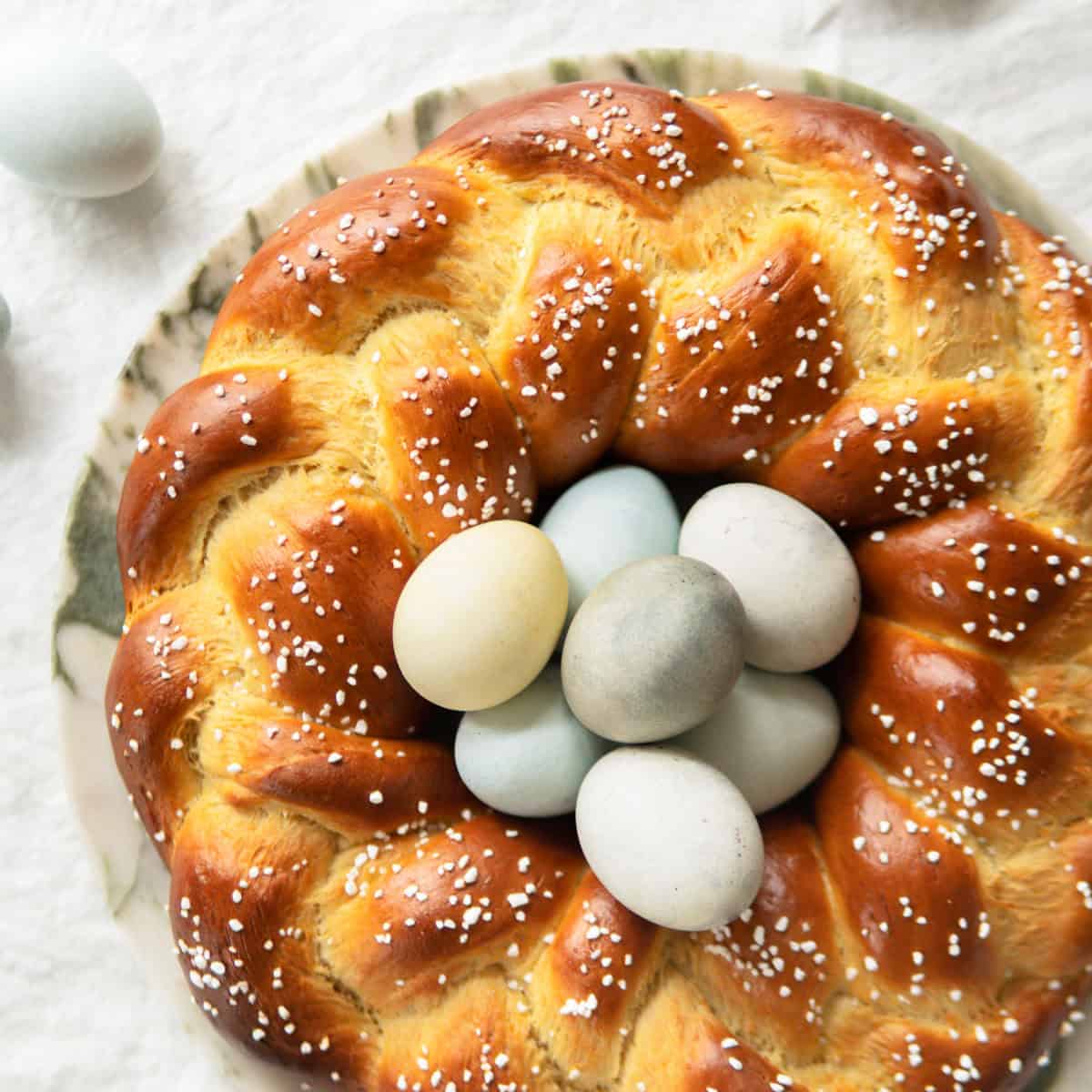
I like topping the middle of the wreath with dyed eggs, making it look like the prettiest bird's nest. Whether you enjoy it simply with butter and jam (that's my favorite!) or as part of a full German food spread, this easy Easter dessert brings both beauty and tradition into your home.
This recipe uses a simple and quick dough that comes together effortlessly, especially with the help of a stand mixer.
Jump to:
Why you'll love this recipe
- It's a simple and quick dough to make (thank you, stand mixer!)
- Has that signature, fluffy German texture and slightly sweet taste
- Makes a gorgeous table centerpiece for your Easter celebration
- Switch things up this Easter and celebrate it with an authentic German tradition
Ingredients
Let’s talk about what goes into this festive Easter bread. The ingredients are simple and you probably already have them in your pantry and fridge. Each one plays a special role in creating that fluffy, golden, barely sweet bread that’s so loved in authentic German bread recipes. See the recipe card below for detailed ingredient amounts.
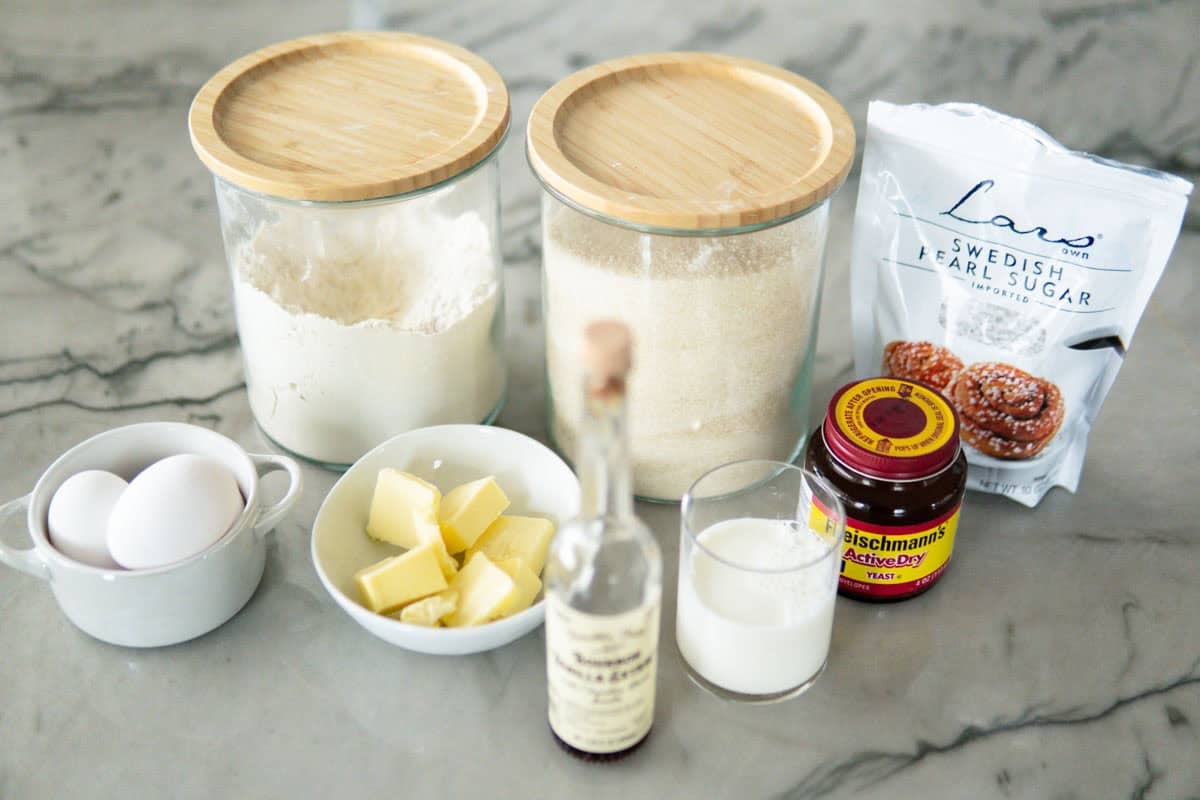
- Milk. This makes for a soft, fluffy dough. I typically use whole milk or 2 percent milk.
- Yeast. This is what gives this bread its lovely rise and fluffy interior. I always use active-dry yeast, as it's closest to German yeast.
- Butter. Makes the dough tender and flavorful. I typically use unsalted butter in baking, as it makes it easier to control the salt level in a recipe and get it just right. However, if using salted butter, please skip adding additional salt.
- Sugar. Gives the bread its mild sweetness. I use granulated sugar inside the dough
- Flour. I use all-purpose flour for all of my baking.
- Salt. Really helps to bring out the flavor of this bread. I love adding it for that reason.
- Eggs. The eggs really give the bread the right kind of structure that it needs. I also brush some on top for that iconic shine.
- Vanilla extract or lemon zest (optional). Gives a subtle aromatic flavor and is so good! I typically add both!
- Pearl sugar (optional). Adds a lovely crunch and sparkle on top, as well as a subtle sweet note. You could totally skip adding it though in case you can't get your hands on it. I love it though, as it gives the bread its signature look.
How to make Easter bread
This is a simple, mostly hands-off Easter bread recipe you’ll come back to year after year. Find the detailed step-by-step instructions in the recipe card below.
Step 1: Activate the Yeast
In a small bowl, stir together the lukewarm milk and yeast. Let it sit for about 5 minutes until it looks bubbly.
Step 2: Melt the Butter
Gently melt the butter in a small saucepan. Set aside to cool slightly.
Step 3: Make the Dough
In a stand mixer bowl fitted with a dough hook, combine flour, salt, and sugar. Add the yeast mixture, melted butter, eggs, and vanilla extract or lemon zest, if using. Knead on low until the dough is smooth and elastic, about 8 minutes.
Step 4: Let It Rise
Cover the bowl and place it in a warm spot. Let the dough rise until doubled in size, about 30 minutes to 1 hour.
Step 5: Shape & Braid
Divide the dough into 3 equal pieces. Briefly knead each to release air bubbles, then roll into logs about 30 to 35 inches (75 to 90 cm) long. To make a seamless wreath, offset the log ends by about 1 inch (2 cm) before braiding. Braid tightly to the end, then form into a circle, tucking the ends under.
Don’t stress if braiding feels tricky. Check out the step-by-step images I am providing here or just braid them parallel like a classic loaf. It’ll be beautiful either way!
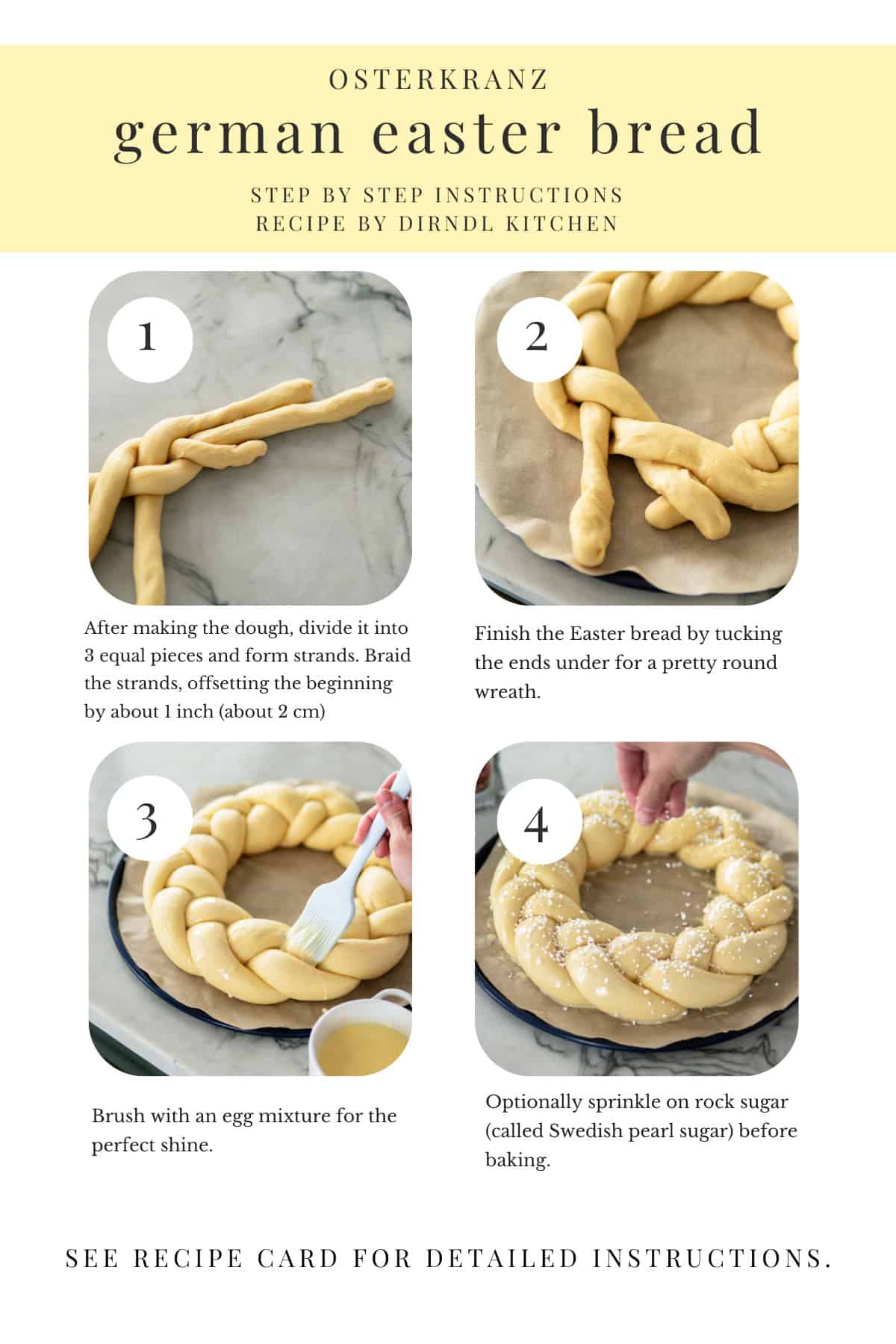
Step 6: Second Rise
Place the braided wreath onto a parchment-paper lined baking sheet, cover loosely with a kitchen towel, and let rise again for 30 minutes.
Step 7: Bake
In the meantime, preheat oven to 320°F (160°C) on the convection setting. Whisk the remaining egg with some milk and brush over the wreath using a pastry brush. Sprinkle with pearl sugar if desired. Bake on the middle rack for 20 minutes, then cover with foil and bake an additional 6 to 10 minutes, until golden and springy.
No convection setting? Bake at 345°F (175°C) conventional and rotate the sheet halfway through baking.
Step 8: Cool & Serve
Cool for at least 30 minutes on a wire rack. Place dyed eggs in the middle for a festive Easter nest look.
How to enjoy Osterkranz
We love slicing into our freshly baked Osterkranz and butter and jam all over it. There’s truly nothing better! It pairs beautifully with a hot cup of coffee or tea and makes a stunning addition to any Easter brunch or as an afternoon treat, as it's so common to eat it that way in Germany.
Try serving it alongside a cute Osterlamm (Easter lamb cake), a Rüblikuchen (Swiss carrot cake), another one of our favorite Easter recipes, or add some savory balance with my Healthy Egg Salad and Creamy German Potato Salad. Each of these recipes would be fun, new ways to integrate German foods for Easter.
While Osterzopf is best enjoyed fresh, you can easily freeze the bread once it has cooled completely. Just thaw it at room temperature for about three hours, and it’s ready to go again. Soft, slightly sweet, and 200 percent satisfying.
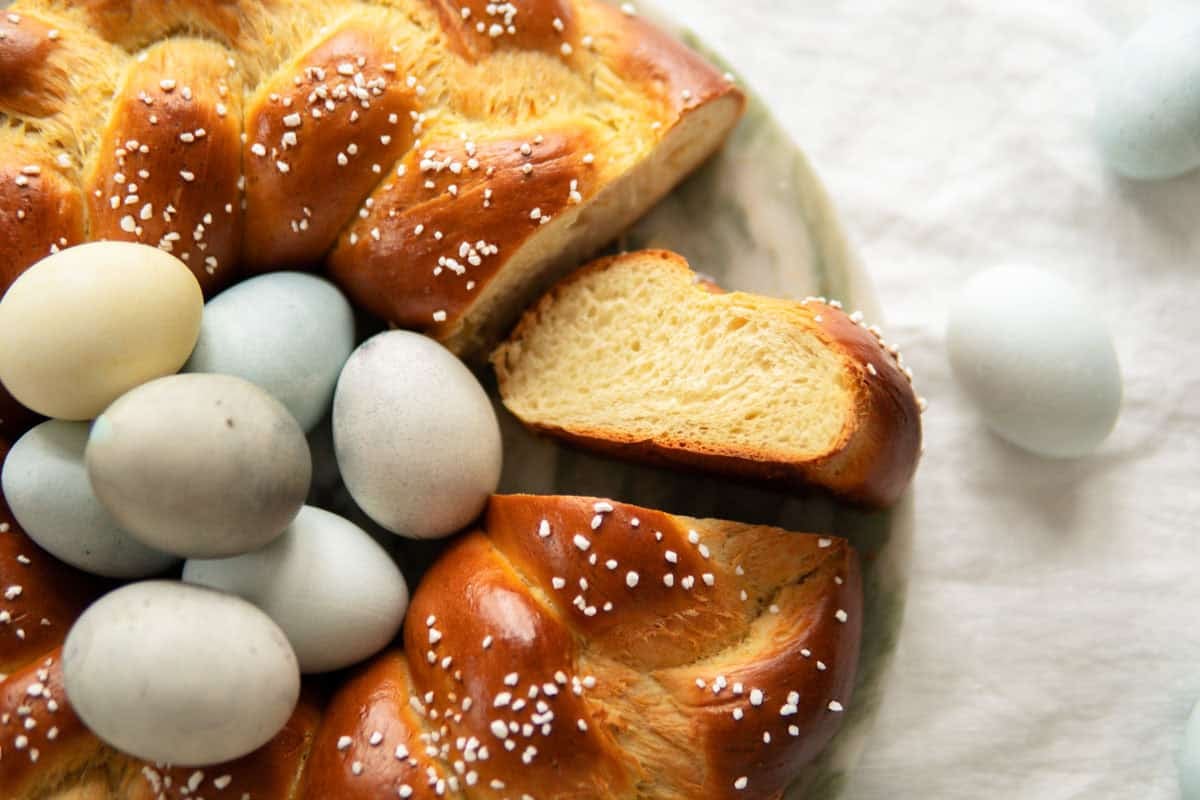
For more German food inspiration, be sure to browse my full German Easter Recipe Collection, Spring recipes, or dive into all things Easter on the blog.
Don’t miss a recipe!
Love discovering new authentic German recipes? Subscribe to my newsletter for German recipe inspiration and German traditions delivered straight to your inbox.
Frohe Ostern (happy Easter) and have fun baking!
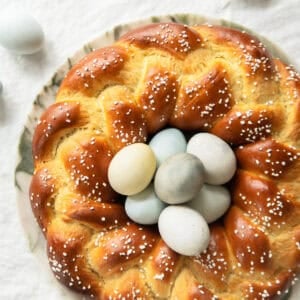
German Easter bread (Osterkranz)
Equipment
- 1 Stand Mixer for kneading your dough! It's a big help and I use mine all the time.
- 1 Zester to zest lemon peel, if using
- 1 Pizza Baking Pan I prefer baking my Easter bread on a round pan like this, but a rimless cookie sheet will work great, too.
- 1 cooling rack to transfer the Easter bread to after baking
- 1 bread knife for slicing your Osterzopf
Ingredients
Bread
- 14 grams dry yeast 2 small pouches
- 200 milliliters milk I use whole or 2% milk
- 75 grams unsalted butter
- 500 grams all-purpose flour
- 1 pinch salt the rock salt I linked it my favorite that I use for all of my baking and cooking
- 75 grams granulated sugar
- 2 eggs size US large
- 1 teaspoon pure vanilla extract optional
- ½ teaspoon lemon zest optional
Egg Wash & Topping
- 1 egg size US large
- 45 milliliters milk
- pearl sugar for sprinkling on top, optional
Instructions
- In a small bowl, add the yeast and lukewarm milk and set aside to activate, about 5 minutes. It should look bubbly and happy.200 milliliters milk, 14 grams dry yeast
- In a small saucepan, melt the butter over medium-low heat.75 grams unsalted butter
- In the bowl of a stand mixer fitted with the dough hook attachment, add the flour, salt, and sugar; stir to combine. Add the bubbly yeast mixture, melted butter, 2 of the eggs and, if using, the vanilla or lemon zest. Mix at low speed until a smooth dough forms, about 8 minutes.500 grams all-purpose flour, 1 pinch salt, 75 grams granulated sugar, 2 eggs, 1 teaspoon pure vanilla extract, ½ teaspoon lemon zest
- Cover the bowl with plastic wrap or a tight-fitting lid and set aside in a warm spot until the dough has doubled in size, 30 minutes to 1 hour.
- Preheat the oven to 320°F (160°C) on the convection (Umluft) setting (see Note if your oven doesn’t have convection) and line a baking sheet with parchment paper or a silicone baking mat.
- On a lightly floured work surface, using a bench scraper or a sharp knife, shape three logs of even thickness around 30 to 35 inches (about 75 cm to 90 cm) long and start braiding by off-setting the length of the logs by just about an inch (2 cm). This is so you get a more seamless look by easily tucking the ends under without them meeting at exactly the same spot. I simply braid them all to the very end, then tuck the ends together.It’s best to look at the step-by-step images for this tip. If this is too complicated, just start braiding them perfectly parallel to each other. It will be pretty regardless!
- In a small bowl, whisk together the remaining egg and 3 tablespoons (45 ml) of milk. Brush on the egg-milk-mixture, sprinkle with pearl sugar (if using) and bake for 20 minutes on the middle rack.Then cover with aluminum foil and bake for 6 to 10 more minutes or until the bread springs back when you gently press on the thickest part of it.1 egg, 45 milliliters milk, pearl sugar
- Transfer to a cooling rack to cool for about 30 minutes before slicing and serving. Serve with dyed boiled eggs in the middle for a cute bird’s nest look for Easter! My favorite way to eat this bread is with a spread of good butter and delicious jam. So good!

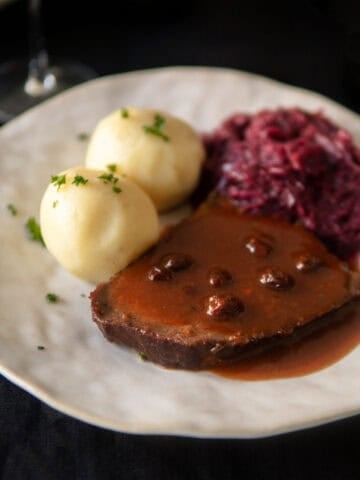
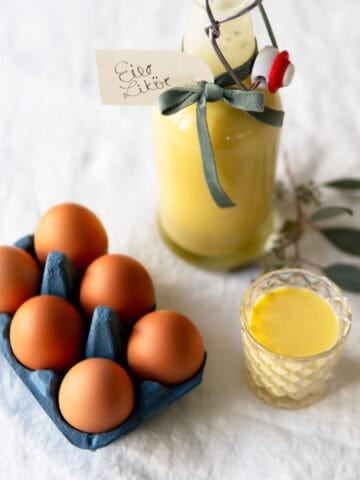

Joan Draedy
Love your site! The recipes are wonderful and make me home sick for Germany. I was fortunate to live near Wiesbaden for 4 years and have had problems finding authentic recipes since I have returned. Thank you!
dirndlkitchen
I am so happy to have you, Joan! I hope you love this Osterkranz recipe and will try many more! Let me know if you ever have any questions! Sophie